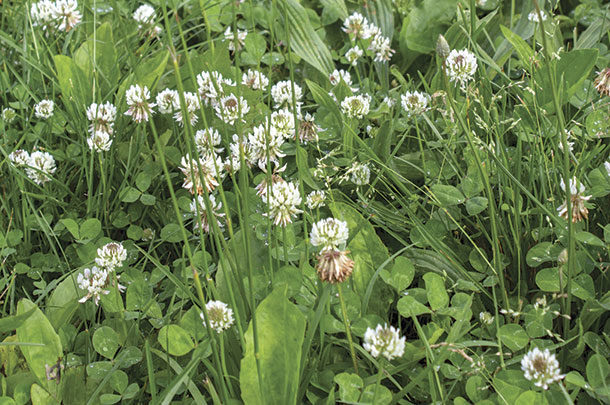At high levels of phytoestrogen intake, these effects have occasionally impacted reproductive functions. In some cases, phytoestrogens in soy-based imitation milk have resulted in infertility in women. At low levels, the effects of phytoestrogens can be quite positive.
For example, medical researchers have found promising results treating hot flashes in postmenopausal women using phytoestrogens.
In the forage world, the plants highest in phytoestrogens are red clover, subterranean clover and alfalfa. The three most biologically active phytoestrogen compounds are formononetin, biochanin A and coumestrol. Coumestrol is found in overly mature and disease-stressed alfalfa.
This is rarely an issue because alfalfa is almost always harvested in an immature stage, and most commercial varieties have a high degree of resistance to most of the diseases associated with high coumestrol levels. Formononetin and biochanin A are very prevalent in red and subterranean clovers, and their concentrations are generally highest in the young, vegetative materials (Figure 1).

These phytoestrogens have been implicated in “clover disease,” where female animals consuming high phytoestrogen levels fail to ovulate and conceive, driving down reproductive success.
Reproductive issues can happen, but are rare
The first reports of poor reproductive performance were made in the 1940s in ewes grazing pure subterranean clover fields in Australia. After 20 years of research, Australian scientists had worked out that the phytoestrogens in clover were interfering with normal reproductive function.
While all of the phytoestrogens were at play, it was the formononetin that was found to be the most biologically active. Formononetin is broken down in the rumen into equol, a compound that has a very similar structure to the mammalian estrogen hormone, estradiol-17 (alpha).
In most cases, the presence of additional estrogen-mimicking compounds in the mammalian body has minimal side effects, and often, it may have a growth promotant effect on livestock. In fact, many of the implants used as growth promotants in livestock include estradiol or compounds that have a similar effect. Yet these growth promotants have been refined so that the dose provides just the right amount.
In the aforementioned cases of sheep infertility, it was found that so much clover was being consumed that an extraordinarily high level of equol was being produced. This high concentration of equol disrupted the reproductive functions in the ewes and rendered them infertile.
Subsequent research has indicated that sheep are far more susceptible to these phytoestrogens than are cattle, since cattle excrete a much larger proportion of equol in the urine.
Though red and subterranean clover can, under special circumstances, cause reproductive issues, it is highly unlikely in most situations. Risks are greatest when pure stands of these clover species are grazed, and many of the varieties of these species released in the past 40 years have been screened for low phytoestrogen concentrations.
Phytoestrogen benefits
For years, clovers have primarily been promoted for use as forage crops because of their biological nitrogen (N) fixation ability, which reduces the need for and cost of N fertilizer. A second benefit has been the increased nutritive value, since legumes are high in protein and tend to be high in digestible energy.
In the fescue belt, legumes have also long been promoted as a way to “dilute” the effects of toxic tall fescue. Some argue that the clover is not so much diluting the toxins, as the livestock are performing better because of the high-quality legume forage. But scientists are increasingly finding phytoestrogens in the clover may be counteracting the toxin’s effects.
Earlier, I mentioned that phytoestrogens have been used to treat hot flashes. Medical researchers have found this to be effective because the phytoestrogens appear to relax constricted blood vessels in the body. Scientists at the USDA Agricultural Research Service’s Forage-Animal Production Research Unit (FAPRU) in Lexington, Kentucky, have discovered the biochanin A from red clover also relaxes constricted blood vessels in grazing livestock.
One of the major impacts of the tall fescue toxins is the blood vessel constriction it causes in the animal. Using Doppler ultrasound measurement tools, the scientists at FAPRU have found that feeding red clover phytoestrogens to goats suffering from fescue toxicosis relaxed blood vessel constrictions and reversed the symptoms.
They also measured the performance of stocker cattle grazing a toxic endophyte-infected tall fescue, Kentucky bluegrass, and orchardgrass pasture and compared the results to cattle grazing the pasture when provided either 0.22 ounces per head per day of biochanin A with 3 pounds per head per day of dried distillers grains (DDG) as a carrier or simply the 3 pounds per head per day of DDG.
The additional energy in the DDG improved animal gains by 13 percent over the pasture-only control, but the addition of biochanin A allowed a nearly 30 percent increase in animal gain to occur (Figure 2). Though this work is still in its preliminary phases, the researchers at the FAPRU lab appear to be on track to find a real breakthrough in the treatment of fescue toxicosis.

Natural remedy?
Though phytoestrogens in clover and other legumes have been historically thought of as problematic, emerging science shows they may be beneficial to grazing livestock.
It is too early to say if these phytoestrogens contain homeopathic solutions to animal production challenges, but it further supports the recommendations that clover, and red clover in particular, should be planted in cool-season grass pastures, especially where toxic tall fescue is present. ![]()
PHOTO: The concentration of two phytoestrogens, formononetin and biochanin A, in red clover plant parts are shown at various stages of maturity. Concentrations of both compounds are highest in the leaves. Staff photo.

-
Dennis Hancock
- Professor and Extension Forage Agronomist
- University of Georgia
- Email Dennis Hancock









